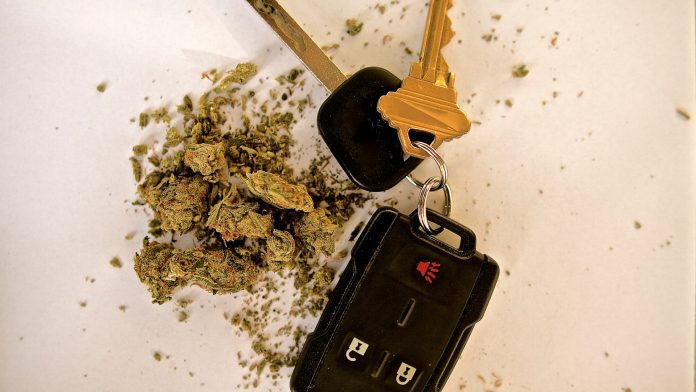
A comprehensive, two-year randomised trial has unveiled the effects of driving after smoking cannabis, illustrating the risks of getting behind the wheel under the influence.
The study was conducted at the Center for Medicinal Cannabis Research (CMCR) at the University of California San Diego School of Medicine and analysed how varying levels of THC impact an individual’s ability to drive. Cannabis use has steadily risen in the US in recent years, with 18 states legalising recreational use, 13 decriminalising its use, and 36 having medical cannabis laws. This new paradigm has raised concerns about the dangers of driving after smoking cannabis; how does it affect the abilities, real or perceived, of drivers under the influence?
The findings of the study are published in JAMA Psychiatry.
Investigating driving after smoking cannabis
The University researchers recruited 191 frequent cannabis users to conduct their study. The participants were given cannabis with varying levels of delta-9-tetrahydrocannabinol (THC), the psychoactive component of cannabis, or a placebo.
Next, they completed a series of driving simulation tests over several hours. The participants were given a Composite Drive Score (CDS) that assessed essential simulated driving variables, such as swerving in the lane, responding to divided attention tasks, and following a lead car. However, all of the individuals were not as significantly impacted when driving after smoking cannabis compared to the placebo group, with 50% being described as ‘impaired’.
The decline was sharpest in the 30-minute and one hour 30-minute marks of driving after smoking cannabis, then steadily levelled to borderline difference with the placebo at the three hours-30-minute mark, with no difference at four hours30-minutes. Notably, the team said that driving scores were not impacted by different levels of the THC content in the cigarettes, with the 5.9% and 13.4% THC groups performing similarly. This indicates the users ‘self-titrated’ by smoking in such a way to achieve similar levels of intoxication.
Moreover, the group that had the highest cannabis use in the last six months demonstrated significantly higher blood THC concentrations after smoking but did not perform worse than those with lower THC concentrations, showing behavioural tolerance. Nevertheless, these users appeared to compensate by ingesting more THC, meaning they performed no better than less-frequent users.
Thomas Marcotte, PhD, the first and senior author of the study and co-director of CMCR and a professor of psychiatry at UC San Diego School of Medicine, said: “Although users in the THC group felt impaired and were hesitant to drive at 30 minutes, by one hour 30-minutes they believed the impairment was wearing off and were more willing to drive.
“This was despite their performance not significantly improving from the 30-minute point. This may indicate a false sense of safety, and these first few hours may constitute a period of greatest risk since users are self-evaluating whether it is safe to drive.”
The investigation discovered no correlation between post-smoking blood THC concentrations and simulator performance.
Co-author Robert Fitzgerald, PhD, professor of clinical pathology at UC San Diego School of Medicine and director of the Toxicology Laboratory and associate director of Clinical Chemistry Laboratory at UC San Diego Health, said: “The complete lack of correlation between blood concentrations and driving performance was somewhat surprising. It’s strong evidence against developing ‘per se’ driving under the influence statutes.”
Per se laws
Per se, Latin for ‘by itself’, implement a statutory violation if a legal standard is breached; for example, blood-alcohol concentration in driving under the influence laws. The researchers stated that their results signify that driving after smoking cannabis leads to a diminished ability to drive (in simulators). However, when experienced users managed their intake, impairment could not be estimated based on the THC of their cigarette, behavioural tolerance, or THC blood concentrations.
Marcotte commented: “Our study of a large group of regular users underscores the complexity in understanding the relationship between cannabis intake and driving decrements, reinforces the challenges in communicating the varying level of risks associated with use and the difficulty in identifying the subset of individuals most at risk for impaired driving.”
California State Assembly member, Tom Lackey, said: “This groundbreaking research indicates that cannabis use does impair driving ability, but factors differ from alcohol. For example, these data show that per se laws for THC levels are not supported scientifically. It also underscores the need for further research on this topic. Policymakers still need a better understanding of the effects of different ways of consuming higher concentration products to charter a path forward.”
Co-author Igor Grant, MD, CMCR director and Distinguished Professor of Psychiatry at UC San Diego School of Medicine, said: “In studying medicinal cannabis, we need to be attentive to the fact that all medicines have risks as well as benefits. Here, Dr Marcotte and colleagues demonstrate that at least some drivers have reduced ability for several hours after intake. As we move forward, we need to learn more precisely who does and does not constitute a driving risk and appropriately label cannabinoid medicines.”









